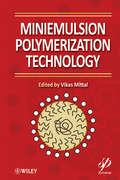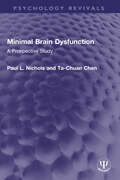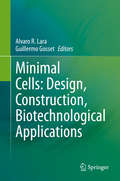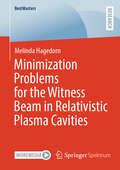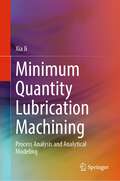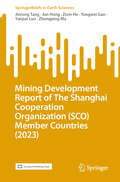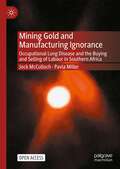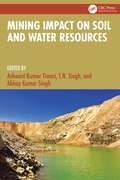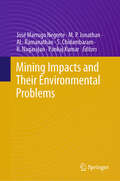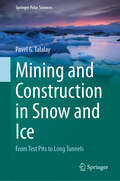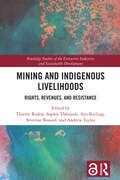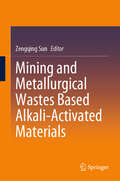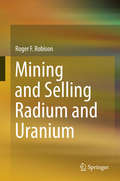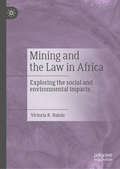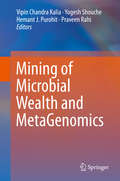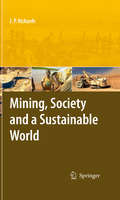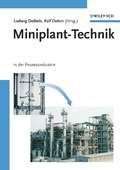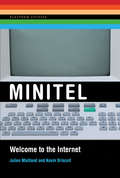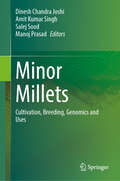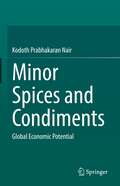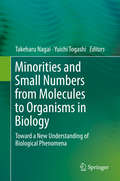- Table View
- List View
Miniaturized Testing of Engineering Materials (Advanced Materials Science and Technology)
by Baldev Raj V. Karthik K.V. KasiviswanathanThis book is a comprehensive overview of methods of characterizing the mechanical properties of engineering materials using specimen sizes in the micro-scale regime (0.3-5.0 mm). A range of issues associated with miniature specimen testing like correlation methodologies for data transferability between different specimen sizes, use of numerical simulation/analysis for data inversion, application to actual structures using scooped out samples or by in-situ testing, and more importantly developing a common code of practice are discussed and presented in a concise manner.
Minicircle and Miniplasmid DNA Vectors: The Future of Non-viral and Viral Gene Transfer
by Martin SchleefThis first title on the topic provides complete coverage, including the molecular basis, production and possible biomedical applications. Written by the most prominent academic researchers in the field as well as by researchers at one of the world's leading companies in industrial production of minicircle DNA, this practical book is aimed at everyone who is directly or indirectly involved in the development of gene therapies.
Miniemulsion Polymerization Technology (Wiley-Scrivener #34)
by Vikas MittalExplains miniemulsion technology and techniques and why they have many distinct advantages over the conventional emulsion polymerization technology Miniemulsion Polymerization Technology comprises 10 papers by many of the world's experts on the subject. It summarizes the recent advances in miniemulsion polymerization technology including the advances on the selection of surfactants and co-surfactants, the expansion of miniemulsion technology in various polymers and co-polymer systems, and the use of miniemulsion polymerization for the synthesis of advanced polymer particle morphologies. There have been a large number of texts on emulsion and other forms of polymerization methods, but miniemulsion polymerization, though it provides unique routes for polymer particle synthesis, has been neglected. This edited volume: Details the use of miniemulsion polymerization in encapsulation, core shell functional particles, nitroxide mediated polymerization, atom transfer radical polymerization or radical addition fragmentation chain transfer polymerization, to generate advanced polymer nanoparticles or organic-inorganic composite particles Examines the wide spectrum of commercial possibilities of miniemulsion polymerization Provides both introductory material as well as deep insights into the synthesis of polymer particles
Minimal Brain Dysfunction: A Prospective Study (Psychology Revivals)
by Paul L. Nichols Ta-Chuan ChenThe concept of Minimal Brain Dysfunction (a previous term for ADHD) has had a tumultuous, and some would say, checkered history. Originally published in 1981, this title was one of a series of volumes dealing with specific developmental problems in children whose mothers registered for prenatal care in the Collaborative Perinatal Project (NCPP) of the National Institute of Neurological and Communicative Disorders and Stroke (NINCDS). In this volume, relationships between symptoms of minimal brain dysfunction and more than 300 prenatal and postnatal variables are examined in a cohort of nearly 30,000 7-year-old children. Despite greater understanding more recently, diagnosis and treatment continue to cause controversy. This is an early investigation into the concept of MBD and its causes, today it can be read in its historical context.
Minimal Cells: Design, Construction, Biotechnological Applications
by Guillermo Gosset Alvaro R. LaraThis book provides a comprehensive overview of the design, generation and characterization of minimal cell systems. Written by leading experts, it presents an in-depth analysis of the current issues and challenges in the field, including recent advances in the generation and characterization of reduced-genome strains generated from model organisms with relevance in biotechnology, and basic research such as Escherichia coli, Corynebacterium glutamicum and yeast. It also discusses methodologies, such as bottom-up and top-down genome minimization strategies, as well as novel analytical and experimental approaches to characterize and generate minimal cells. Lastly, it presents the latest research related to minimal cells of serveral microorganisms, e.g. Bacillus subtilis.The design of biological systems for biotechnological purposes employs strategies aimed at optimizing specific tasks. This approach is based on enhancing certain biological functions while reducing other capacities that are not required or that could be detrimental to the desired objective. A highly optimized cell factory would be expected to have only the capacity for reproduction and for performing the expected task. Such a hypothetical organism would be considered a minimal cell. At present, numerous research groups in academia and industry are exploring the theoretical and practical implications of constructing and using minimal cells and are providing valuable fundamental insights into the characteristics of minimal genomes, leading to an understanding of the essential gene set. In addition, research in this field is providing valuable information on the physiology of minimal cells and their utilization as a biological chassis to which useful biotechnological functions can be added.
Minimally Invasive Medical Technology
by John G. WebsterMinimally invasive medicine has the goal of providing health care with minimal trauma. When minimally invasive surgery is utilized, it reduces the length of hospital stays, lowers costs, lowers pain, and reduces blood loss. Other minimally invasive techniques minimize radiation exposure, tissue damage, and drug side effects. Collecting cont
Minimization Problems for the Witness Beam in Relativistic Plasma Cavities (BestMasters)
by Melinda HagedornThis thesis deals with an optimization problem from the field of theoretical plasma physics. Specifically, it deals with the question of how the accelerated electrons are spatially arranged in a plasma wave generated by a laser pulse. An internal structure of this so-called witness beam is of interest for the radiation characteristics of such electron beams, in particular with regard to the coherence of the generated radiation. The resulting internal structure of the electron beam is a result of the interaction of the electrons with each other and the electric fields of the wakefield, therefore it is determined by solving a minimization problem. The thesis builds on previous results in this field and aims to find suggestions for improved algorithms to determine the minimum sought.
Minimum Quantity Lubrication Machining: Process Analysis and Analytical Modeling
by Xia JiThis book focuses on the effect of minimum quantity lubrication (MQL) on the mechanical and thermal history, which will mainly determine the quality of the machined components. By analyzing the details of the lubrication and cooling effects in MQL machining, the book provides readers with an accurate and fast way to predict the residual stress of machined components. These process analyses and quality prediction will be beneficial for understanding the MQL machining theory and its widespread application in industry.
Mining Development Report of The Shanghai Cooperation Organization (SpringerBriefs in Earth Sciences)
by Jun Hong Jinrong Tang Zixin He Yongwei Gao Yanjun Luo Zhongping MaThis is the first research report on mining development in the SCO member countries conducted by a Chinese research institute. It focuses on the economic development, mineral resources endowment and current status of mining development, mining investment environment, and cooperation in geosciences and mining industry between China and other SCO member countries. The aim of this book is to promote the practical cooperation in geoscience and mining in the SCO and to build a closer community of destiny for the development of mining industry in the SCO. The translation was done with the help of artificial intelligence. The present version has been revised technically and linguistically by the authors in collaboration with a professional translator.
Mining Gold and Manufacturing Ignorance: Occupational Lung Disease and the Buying and Selling of Labour in Southern Africa
by Pavla Miller Jock McCullochThis open access book charts how South Africa’s gold mines have systematically suppressed evidence of hazardous work practices and the risks associated with mining.For most of the twentieth century, South Africa was the world’s largest producer of gold. Although the country enjoyed a reputation for leading the world in occupational health legislation, the mining companies developed a system of medical surveillance and workers’ compensation which compromised the health of black gold miners, facilitated the spread of tuberculosis, and ravaged the communities and economies of labour-sending states. The culmination of two decades of meticulous archival research, this book exposes the making, contesting, and unravelling of the companies’ capacity to shape – and corrupt – medical knowledge.
Mining Impact on Soil and Water Resources
by T. N. Singh Ashwani Kumar Tiwari Abhay Kumar SinghThe subject matter of this book is divided into two sections detailing Soil (focussing on geochemistry, contamination, and remediation) and Water (focussing on hydrogeochemistry, crisis, desertification, and modelling) including case studies, review studies, and essential soil remediation and water. It also explores management practices to explain soil–water interaction, acid mine drainage problems, and contamination levels in water and soil resources. The main topics discussed include soil–water interaction, mining impact on water and soil geochemistry, mining impact on water and soil quality, martials impact, groundwater level depletion, contamination evaluation, health risk assessment, water treatment, soil remediation, remote sensing and geographical information system (GIS), contaminant transport modelling, and water/soil resources management. Emphasis is also given to the new approach to sustainable water and soil resources management.Features: Integrates research in soil and environmental resources management in mining. Describes soil resources management in mining regions. Covers water geochemistry and contaminant transport modelling. Provides solutions for acid mine drainage problems. Includes the role of remote sensing and GIS. This book is aimed at researchers and graduate students in soil resources management, mining, and environment science.
Mining Impacts and their Environmental Problems
by R. Nagarajan Al. Ramanathan Pankaj Kumar José Marrugo Negrete M. P. Jonathan S. ChidambaramThis book entitled “Mining Impacts and their Environmental Problems” presents a comprehensive view on various mining activities and a wide spectrum of environmental challenges associated with it. Case studies presented across global south such as Asia, Africa, and Latin America, are the first of its kind which presents a holistic and deep insight (into instead of about?) about this pressing environmental issue. In this book, thirteen chapters present various issues ranging from gold, silver, chromium, lead, coal mining, and its impacts on ambient environmental (soil, water, biodiversity) degradation and ultimately on(healthy living environment instead of human health living? ) human health living in the surrounding area. For this purpose, (different methodologies have been used) they have used different methodologies( for example instead of like using) like using (a) water quality index, hydro-chemical characterization, numerical simulation to identify the extent of pollution caused(by instead of due to?) due to mining activities. Later it (the book) advocates the usage of advance mining technologies such as advanced oxidation processes, decarbonization technologies and a biotechnological approach for the treatment of wastewater being generated due to mining activities or minimizing overall environmental degradation. Finally, it emphasizes on assessing risk zone delineation, vulnerability analysis using cutting edge tools like numerical simulation, GIS and remote sensing, which will help designing robust management plans and sustainable transitions, critically helpful for policy makers or decision makers.
Mining and Construction in Snow and Ice: From Test Pits to Long Tunnels (Springer Polar Sciences)
by Pavel G. TalalaySnow, firn, and ice are the most widespread cryogenic minerals on Earth’s surface. Their properties differ significantly from those of common minerals, and their excavation requires special approaches. The problems of mining and construction in snow and ice could be explained mostly by harsh climate conditions, logistics difficulties, environmental issues and snow-ice related challenges. The primary objective of this book is to list all feasible technologies for mining and construction in snow and ice, and to analyze these from the perspective of applications, problems, and hindrances. Although mining and construction in snow and ice appears exotic, it is significantly common for the production of snow and ice as a source of freshwater and construction material; accessing subglacial ore; the investigation and sampling of near-surface layers; glacier geoengineering works; recovering of snow-buried objects; construction of subsurface shelters for living, working, and military facilities; observation and investigation of glacier beds; construction of sightseeing ice tunnels; and drainage of ice-dammed proglacial lakes.
Mining and Indigenous Livelihoods: Rights, Revenues, and Resistance (Routledge Studies of the Extractive Industries and Sustainable Development)
by Andrew Taylor Sophie Thériault Thierry Rodon Arn Keeling Séverine BouardThis book maps the encounters between Indigenous Peoples and local communities with mining companies in various postcolonial contexts.Combining comparative and multidisciplinary analysis, the contributors to this volume shine a light on how the mining industry might adapt its practices to the political and legal contexts where they operate. Understanding these processes and how communities respond to these encounters is critical to documenting where and how encounters with mining may benefit or negatively impact Indigenous Peoples. The experiences and reflections shared by Indigenous and non-Indigenous contributors will enhance our understanding of evolving practices and of the different strategies and discourses developed by Indigenous Peoples to deal with mining projects. By mobilizing in-depth fieldwork in five regions—Australia, Canada, Sweden, New Caledonia, and Brazil—this body of work highlights voices often marginalized in mining development studies, including those of Indigenous Peoples and women.This book will be of great interest to students and scholars of mining and the extractive industries, sustainable development, natural resource management, and Indigenous Peoples.The Open Access version of this book, available at http://www.taylorfrancis.com, has been made available under a Creative Commons Attribution-Non Commercial-No Derivatives (CC-BY-NC-ND) 4.0 license.
Mining and Metallurgical Wastes Based Alkali-Activated Materials
by Zengqing SunThis book reviews the recent scientific developments on mining and metallurgical wastes-based alkali-activated materials (MMWAAMs). Enormous quantities of solid wastes are generated during the exploitation of ore deposits and the subsequent processing for materials, causing serious environmental problems. Alkali activation is one of the robust technologies that converts mining and metallurgical wastes into value-added materials and offers technological solutions for efficient stabilization of toxic components in mining and metallurgical wastes. Herein, this book presents the development of the design, processing routes, and performances of mining and metallurgical waste-based alkali-activated materials. It highlights in detail the relationships between the physicochemical characteristics of the source materials and the properties of synthesized binders. From the durability perspective, both the applicability of testing protocols and degradation mechanisms are also reviewed with significant experimental and modeling work presented. Furthermore, the transformation paths of initially toxic components during alkali activation, partitioning characteristics, as well as the assemblages of solubility-controlling mineral phases are discussed for detailed environmental compatibility evaluation. In addition, applications and perspectives for future directions of mining and metallurgical wastes-based alkali-activated materials are illustrated. By bringing state-of-the-art knowledge, this book appeals to a broad readership, particularly researchers engaged in material and environmental science, mining and metallurgical engineering, and other related fields.
Mining and Selling Radium and Uranium
by Roger F. RobisonPresented here is the story of the mining and sale of uranium and radium ore through biographical vignettes, chemistry, physics, geology, geography, occupational health, medical utilization, environmental safety and industrial history. Included are the people and places involved over the course of over 90 years of interconnected mining and sale of radium and uranium, finally ending in 1991 with the abandonment of radium paint and medical devices, Soviet nuclear parity, and the Radiation Exposure Compensation Act.
Mining and the Law in Africa: Exploring the social and environmental impacts
by Victoria R. NaluleThe mining sector has been an integral part of economic development in many African countries. Although minerals have been exploited for decades in these countries, the benefits have not always been as visible. This has necessitated reforms including nationalisation of mining activities in the distant past; and currently legal and regulatory reforms. This book gives an insight of these reforms and with reference to the fieldwork research undertaken by the author in some African countries, the book highlights the social and environmental impacts of mining activities in Africa. The central question of the book is, why the mining laws have worked in some countries but not others and what can be done to ensure that these laws are effective? Consequently, the book analyses the legal reforms made in the sector and highlights both the challenges and the opportunities for foreign investors as well as the African governments and local communities. The book will be of great interest to researchers and students in Energy and Geography related fields, as well as to practitioners and policy makers.
Mining of Microbial Wealth and MetaGenomics
by Vipin Chandra Kalia Yogesh Shouche Hemant J. Purohit Praveen RahiThe existence of living organisms in diverse ecosystems has been the focus of interest to human beings, primarily to obtain insights into the diversity and dynamics of the communities. This book discusses how the advent of novel molecular biology techniques, the latest being the next-generation sequencing technologies, helps to elucidate the identity of novel organisms, including those that are rare. The book highlights the fact that oceans, marine environments, rivers, mountains and the gut are ecosystems with great potential for obtaining bioactive molecules, which can be used in areas such as agriculture, food, medicine, water supplies and bioremediation. It then describes the latest research in metagenomics, a field that allows elucidation of the maximum biodiversity within an ecosystem, without the need to actually grow and culture the organisms. Further, it describes how human-associated microbes are directly responsible for our health and overall wellbeing.
Mining, Society, and a Sustainable World
by Jeremy RichardsThis is the first book of peer-reviewed, edited papers that examines the broad subject of the minerals industry in relation to sustainable development. The book takes a proactive, positivist, and solution-oriented approach, while not shying away from identifying the real problems that mining raises in respect to social and economic development, environmental impact, and human development in general.
Miniplant-Technik: in der Prozessindustrie
by Ludwig Deibele Ralf Dohrn Herausgegeben VonNur in Ausnahmefällen lassen sich technische Anlagen für neue Produktionsverfahren der chemischen Industrie an Hand von Literaturdaten und rechnerischer Simulation entwickeln und auslegen. Der übliche Weg des Scale-up führt über den Laborversuch und den anschließenden Aufbau einer Technikumsanlage zur technischen Großanlage. Die Miniplanttechnik ermöglicht die Entwicklung technischer Anlagen in nur einem Schritt vom Labor zur funktionierenden Großanlage. Dabei werden alle Verfahrensschritte im kleinstmöglichen Maßstab, der noch einen reproduzierbaren Dauerbetrieb erlaubt, als Gesamtverfahren aufgebaut und mit Originalprodukten betrieben. Der zeitaufwendige und kostenintensive Zwischenschritt vom Laborversuch über die Technikumsanlage entfällt. Das vorliegende Buch beschreibt allgemeine Anforderungen an Miniplantanlagen und befasst sich mit Fragen, die vor dem Bau einer verfahrensspezifischen Anlage geklärt werden müssen. Hierzu gehören sowohl die Festlegung des Reaktionsablaufs und der Aufarbeitung mit den erforderlichen Verfahrensschritten, Trennsequenzen und Verfahrensabläufe als auch die Verschaltung der Einzelschritte. Den Hauptteil des Buches nimmt die Beschreibung der Apparaturen ein, die heute für die einzelnen verfahrenstechnischen Grundoperationen in Miniplantanlagen zur Verfügung stehen. Chemiker, Verfahrenstechniker und Ingenieure aus der chemischen, petrochemischen und pharmazeutischen Industrie, die sich mit der Planung und dem Aufbau großtechnischer Anlagen befassen, finden in diesem Buch wertvolle Informationen für ihre tägliche Arbeit; Berufseinsteiger und Wissenschaftler an Technischen Hochschulen und Informationen wird ein leichter Einstieg in das faszinierende Gebiet der Miniplanttechnik ermöglicht.
Minitel: Welcome to the Internet (Platform Studies)
by Julien Mailland Kevin DriscollThe first scholarly book in English on Minitel, the pioneering French computer network, offers a history of a technical system and a cultural phenomenon.A decade before the Internet became a medium for the masses in the United States, tens of millions of users in France had access to a network for e-mail, e-commerce, chat, research, game playing, blogging, and even an early form of online porn. In 1983, the French government rolled out Minitel, a computer network that achieved widespread adoption in just a few years as the government distributed free terminals to every French telephone subscriber. With this volume, Julien Mailland and Kevin Driscoll offer the first scholarly book in English on Minitel, examining it as both a technical system and a cultural phenomenon. Mailland and Driscoll argue that Minitel was a technical marvel, a commercial success, and an ambitious social experiment. Other early networks may have introduced protocols and software standards that continue to be used today, but Minitel foretold the social effects of widespread telecomputing. They examine the unique balance of forces that enabled the growth of Minitel: public and private, open and closed, centralized and decentralized. Mailland and Driscoll describe Minitel's key technological components, novel online services, and thriving virtual communities. Despite the seemingly tight grip of the state, however, a lively Minitel culture emerged, characterized by spontaneity, imagination, and creativity. After three decades of continuous service, Minitel was shut down in 2012, but the history of Minitel should continue to inform our thinking about Internet policy, today and into the future.
Minor Histocompatibility Antigens: From the Laboratory to the Clinic
by Elizabeth Simpson Derry RoopenianWith the widespread application of solid tissue and bone marrow transplantation as a treatment for an array of life threatening disorders, there is a pressing need for clinicians and experimentalists to understand the basis of immunological rejection of tissue transplants. While much previous work focuses on characterization of antigens encoded by
Minor Millets: Cultivation, Breeding, Genomics and Uses
by Amit Kumar Singh Manoj Prasad Salej Sood Dinesh Chandra JoshiThis book on minor millets provides a detailed account of their crop biology, agronomy, genetics, breeding, genomic resources, production constraints and value addition. The potential of minor millets in addressing food and nutritional insecurities is well-recognized. Government of India declared millets as &“Shree Anna&” as they are a powerhouse of nutrients and possess strong climate-resilience properties. Minor millet species, such as finger millet, foxtail millet, barnyard millet, little millet, proso millet, kodo millet, fonio millet, and teff, are the oldest-cultivated crops that are used for both food and fodder in semi-arid regions of Asia and Africa. In the recent times, they have become important due to their unparalleled nutritional profile, recognized nutraceutical properties, versatile environmental adaptability, and ability to flourish in low input agriculture and organic cultivation. However, their cultivation and consumption are declining due to lack of awareness and unavailability of literature to a broad range of audience. This book serves as reference material for researchers and students engaged in genetic improvement, biochemistry, processing, and value addition of minor millets.
Minor Spices and Condiments: Global Economic Potential
by Kodoth Prabhakaran NairSpices can be classified as major spices, like Black pepper, Cardamom, Turmeric, Ginger etc, and minor spices and condiments, and tree spices. This book will discuss exclusively minor spices and condiments. Spices constitute a very important group of agricultural products, which, since antiquity, have been considered indispensable in the culinary art of flavoring foods. The history of spices is very much entwined with the history of mankind. And, some spice crops like Black pepper predominates in the family of spices. In fact, colloquially, it is called “King”of spices and, another, Cardamom, is called the “Queen”of spices. There is worthwhile amount of published work, on these in addition to Turmeric and Ginger. Both ISO (International Organization for Standardization) and ISI (Indian Standards Institution) (now BIS (Bureau of Indian Standards)) experts concluded, after considerable deliberations, that there is no clear-cut division between “spices” and “çondiments”, and, as such, they have been clubbed together. The term “Spices and Condiments” applies to such natural plant or vegetable products or mixtures, thereof, used in whole or ground form, mainly for imparting flavor, aroma and piquancy to foods and also for seasoning of foods and beverages like soups etc. A detailed survey of published literature proves that there are a number of minor spices, which have tremendous commercial potential, globally. And, an authentic book on these will not only serve as an important guide to the academic community, but, also provide a fillip to industry involved in value addition.
Minorities and Small Numbers from Molecules to Organisms in Biology: Toward A New Understanding Of Biological Phenomena
by Takeharu Nagai Yuichi TogashiThis book provides an accessible introduction to an exciting new field of life science in which the focus is on small numbers of molecules and minorities within cell populations and their significance for the understanding of biological phenomena. Numbers, or quantitative data, are attracting more attention in cell biology following, for example, determination of the absolute copy number of each protein species in each bacterial cell and the recognition of leader cells that drive collective cell migration. Within this context, the authors present recent advances in experimental techniques, biological findings, and theories. A variety of cutting-edge topics and issues are addressed, with explanation of the ways in which recent developments in the field cast light on seemingly straightforward but difficult-to-answer questions. Readers will learn that we are on the verge of a paradigm shift as the importance of cooperation among groups of molecules in live cells is acknowledged. The book is designed to be enjoyable to read and easy to understand. It will be of interest for a wide range of readers, including young researchers and undergraduate/high school students.


